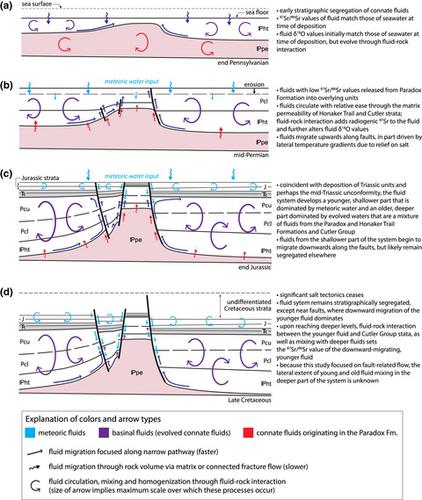当前位置:
X-MOL 学术
›
Basin Res.
›
论文详情
Our official English website, www.x-mol.net, welcomes your feedback! (Note: you will need to create a separate account there.)
A two-stage, fault-controlled paleofluid system at the southern termination of the Gypsum Valley salt wall, Paradox Basin, Colorado, USA
Basin Research ( IF 3.2 ) Pub Date : 2021-12-23 , DOI: 10.1111/bre.12649 Lillian R. Lueck 1, 2 , Mark P. Fischer 1 , Nicholas J. Williams 1 , Kerstin Drost 3 , Justin P. Dodd 1 , David M. Chew 3
Basin Research ( IF 3.2 ) Pub Date : 2021-12-23 , DOI: 10.1111/bre.12649 Lillian R. Lueck 1, 2 , Mark P. Fischer 1 , Nicholas J. Williams 1 , Kerstin Drost 3 , Justin P. Dodd 1 , David M. Chew 3
Affiliation

|
This study combines field structural analysis with thin-section petrography, U-Pb dating, and strontium, carbon and oxygen isotopic analysis of calcite fracture fills to constrain the evolution of the 2-5 km scale paleofluid system around the faulted, plunging fold nose comprising the southern termination of the Gypsum Valley salt wall in the Paradox Basin, U.S.A. Brittle deformation in this region began with the formation of a down-to-the-northeast, counter-regional fault and then progressed into jointing and faulting in a radial pattern, followed by jointing in a concentric pattern. Coupled with increases in fracture abundance toward the faults, multiple stages of mineralization suggest that the faults served as efficient and long-lived conduits for vertical fluid migration. Although fracture cement textures and calcite colour are variable throughout the area, the distribution of these characteristics does not correlate with fracture orientation, relative age, stratigraphic or structural position. Irrespective of the type of calcite comprising the fracture cements, δ13C values average near −7‰ (VPDB), whereas δ18O values cluster into groups whose averages are roughly 6‰ apart, with the more negative grouping stratigraphically restricted to fracture cements in Jurassic rocks. The stratigraphic segregation of δ18O values suggests the paleofluid system contained two distinct paleofluids, a more recent one comprised of meteoric waters and an older one comprising brine that originated in Pennsylvanian strata. 87Sr/86Sr ratios in fracture-filling calcite cements indicate that the older fluid underwent fluid-rock interaction with Permian strata and that this evolved fluid migrated upwards along the faults until the Triassic or Jurassic. Thereafter, fluid migrating along the faults was more meteoric and appears to have migrated downward along the faults, where it interacted with Permian strata. Consistent U-Pb dates from carbonates precipitated from the older fluid suggest this stage of the paleofluid system was active around 240 Ma. Local burial history models and published temperatures for fracture cements elsewhere in the basin suggest the younger stage of the paleofluid system occurred during the Latest Cretaceous to Oligocene. This study highlights the spatial and temporal complexity of fluid systems in the vicinity of salt structures and emphasises the need to interpret them through careful integration of high resolution stratigraphic and structural data in the context of evolving salt tectonics.
中文翻译:

美国科罗拉多州帕拉多克斯盆地石膏谷盐墙南端的两阶段断层控制古流体系统
本研究将现场结构分析与薄片岩相学、U-Pb 测年以及方解石裂缝填充物的锶、碳和氧同位素分析相结合,以约束断层、下陷褶皱鼻周围 2-5 公里规模的古流体系统的演化,包括美国 Paradox 盆地 Gypsum Valley 盐墙南端 该区脆性变形开始于形成北东向的反区域断层,然后呈放射状发展为节理断层,然后以同心模式连接。再加上向断层的裂缝丰度增加,多个成矿阶段表明,断层是垂直流体运移的有效且长寿命的管道。尽管整个地区的裂缝胶结物质地和方解石颜色各不相同,但这些特征的分布与裂缝方向、相对年龄、地层或构造位置无关。与包含断裂胶结物的方解石类型无关,δ13 C 值平均接近 -7‰ (VPDB),而 δ 18 O 值聚集成平均相差约 6‰ 的组,更负的组在地层上仅限于侏罗纪岩石中的断裂胶结物。δ 18 O 值的地层分离表明古流体系统包含两种不同的古流体,一种较新的由大气水组成,另一种由起源于宾夕法尼亚地层的盐水组成。87高级/ 86裂缝充填方解石胶结物中的 Sr 比率表明,较老的流体与二叠纪地层发生了流体-岩石相互作用,并且这种演化的流体沿着断层向上迁移,直到三叠纪或侏罗纪。此后,沿断层迁移的流体更加平稳,似乎沿断层向下迁移,并与二叠纪地层相互作用。来自较旧流体沉淀的碳酸盐的一致 U-Pb 年代表明,该阶段的古流体系统在 240 Ma 左右活跃。盆地其他地方的当地埋藏历史模型和已发表的裂缝胶结物温度表明,古流体系统的较年轻阶段发生在晚白垩世至渐新世期间。
更新日期:2021-12-23
中文翻译:

美国科罗拉多州帕拉多克斯盆地石膏谷盐墙南端的两阶段断层控制古流体系统
本研究将现场结构分析与薄片岩相学、U-Pb 测年以及方解石裂缝填充物的锶、碳和氧同位素分析相结合,以约束断层、下陷褶皱鼻周围 2-5 公里规模的古流体系统的演化,包括美国 Paradox 盆地 Gypsum Valley 盐墙南端 该区脆性变形开始于形成北东向的反区域断层,然后呈放射状发展为节理断层,然后以同心模式连接。再加上向断层的裂缝丰度增加,多个成矿阶段表明,断层是垂直流体运移的有效且长寿命的管道。尽管整个地区的裂缝胶结物质地和方解石颜色各不相同,但这些特征的分布与裂缝方向、相对年龄、地层或构造位置无关。与包含断裂胶结物的方解石类型无关,δ13 C 值平均接近 -7‰ (VPDB),而 δ 18 O 值聚集成平均相差约 6‰ 的组,更负的组在地层上仅限于侏罗纪岩石中的断裂胶结物。δ 18 O 值的地层分离表明古流体系统包含两种不同的古流体,一种较新的由大气水组成,另一种由起源于宾夕法尼亚地层的盐水组成。87高级/ 86裂缝充填方解石胶结物中的 Sr 比率表明,较老的流体与二叠纪地层发生了流体-岩石相互作用,并且这种演化的流体沿着断层向上迁移,直到三叠纪或侏罗纪。此后,沿断层迁移的流体更加平稳,似乎沿断层向下迁移,并与二叠纪地层相互作用。来自较旧流体沉淀的碳酸盐的一致 U-Pb 年代表明,该阶段的古流体系统在 240 Ma 左右活跃。盆地其他地方的当地埋藏历史模型和已发表的裂缝胶结物温度表明,古流体系统的较年轻阶段发生在晚白垩世至渐新世期间。



























 京公网安备 11010802027423号
京公网安备 11010802027423号